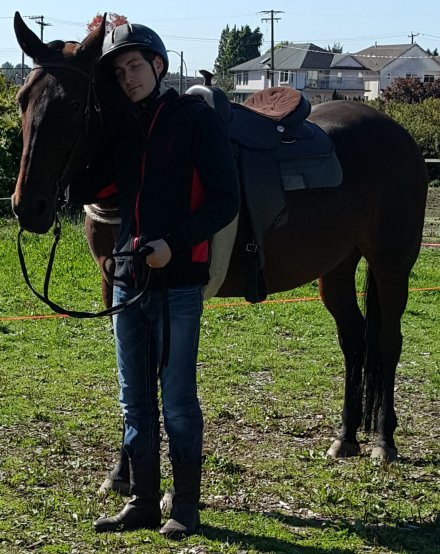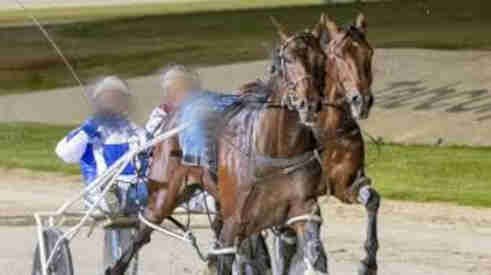

Most Standardbred horses are adopted from either the race tracks as pacers or trotters, the farm animal auctions or the rescues that take in former racing horses such as Thoroughbred, Quarter horses and pacers (Standardbreds).
Standardbred horses are well known for their solid and reliable temperaments which helps considerably in training. Horses that have been raced will need retraining no matter whether a Quarter horse, Thoroughbred horse or Standardbred horse.
Standie talents are many however like all former race horses there is rehabilitation and retraining required in preparation for a new career. A vet inspection to determine if there are any physical injuries that might prevent some of the more challenging equine sports is always recommended first when you adopt a pacer.
The biggest difference between these three breeds that are bred for racing is that both the Quarter horse and the Thoroughbred
have had a rider on their back: The horses know what a saddle is and how to be saddled. The trotters and pacers
(Standardbreds) have not been ridden or saddled as part of their racing career training - these horses are trained as harness
racers that pull a sulky with a sitting rider. All three breeds know how be bridled.

All three racing breeds, the Quarter horse, Standardbred horse and the Thoroughbred, are superb athletes. The breeds are bred primarily for that purpose in the 21st century. One would think that the Quarter horses and the Thoroughbreds would be the easiest to train since they already know how to be ridden and saddled. Surprisingly however the Standardbred has a stellar personality with a tolerance rating that is one of the highest of all breeds - not much fazes a Standardbred horse which is therefore considered a very safe horse to handle and to ride with retraining. For this reason many prefer to retrain the Standardbred horse.
Standardbred horses are taught to pace with the use of hobbles and equipment which keep their legs in the pace. If they 'break' the pace into a canter they will be disqualified in a race. This is why Standardbreds try not to canter some are punished for the canter. Yet, Standardbred horses are first and foremost horses and horses are born knowing how to walk, trot, and canter (as well as gallop!).
People often think that they can force a pacer to trot or canter. Not only is this cruel because the horse doesn't have the years of trot and canter balance and running practice at the trot and canter gait, using force also scares the horses so that they try to pace even more erratically and faster. The angrier you become the more the horse will pace believing that is what you want. Do not use force or punishment ever in your training. The horse will be confused, will panic, will pace and pace faster, and will be very frightened - the horse will not trot or canter - exactly the opposite.
I spent the $25.95 to download the Standardbred Fan Club's retraining video. I saved a bunch of money buying the horse and did the retraining myself like most people do from the video. The more difficult stuff like jumping needs an instructor but the pacers are so mellow you can trust that they wont be 'up in the air' which for horses being so big is reassuring.
Rodney
more retraining video reviews
The Standardbred retraining method was developed fifteen years ago by the Standardbred Fan Club's founder, an accomplished trainer. The retraining method is the most effective and was ground-breaking in teaching pacers to regain the ability to naturally trot and canter with a combination of ground work, lunging work, introduction to the saddle, first ride and the progression to the trot and the canter with a rider. In those training sessions the horses are able to develop the necessary muscles to balance with a rider and to be ridden. Because the Standardbred horses are generally laid back and don't run off at the merest unexpected sound or the unknown, they are considered to be one of the easiest horses to work with.
Kootenay learning trasistions from trot to canter / canter to trot without any pacing in the lunging ring.
Lacey had a harness racing career and would only pace after her racing career retirement. Here Lacey is learning to canter without any pacing gait.
Oliver was rescued from certain slaughter after his pacing races at the track. Here Oliver is warming up prior a dressage competition.
Traditional riding
training will not change the pacing - Standardbreds require retraining which the Standardbred Fan Club first
showed the public with its Standardbred Horse Training - Retraining The Pacer video.
The method to retrain pacers and trotters was slightly
different from training other breeds. In 2009, that method was documented in a step by step format with time lines
so that anyone could begin to retrain the Standardbred horse (pacer or trotter).
The DVD was made primarily for the novice and rider with some riding experience who have adopted or brought home a Standardbred horse from the race track or adoption organization although it will also be useful to instructors and trainers.
Standardbred Horse Training - Retraining The Pacer video
Standardbred Fan Club
The pace is comfortable to ride however the horses cannot jump or do other equestrian sports with the pace. Some individuals don't mind the pacing since it is a smooth riding gait on the trails. One of the problems with pacing is that the horses cannot turn sharply, it is a gait intended to run straight-forward. If a turn is needed the horse should be brought back to the walk. Pacing is not suited for turning at all.
People who have Standardbred horses will tell you that they are one of the safest horses to be with. They are mostly relaxed and calm. They are easy to groom and have excellent health for the most part. The Standardbred breed is known as the versatile horse - there are so many disciplines the horses are talented for - including trail riding, search and rescue, racing, jumping, endurance, 3 day eventing, barrel racing, movies, trick horses, police work, western riding, english equitation, dressage, parades, therapy horses and wonderful companions. Standardbred horses are willing, put their hearts to work for you and are safe to be with.
"There is not much he isn't willing to do, which from what I have read, is a common trait of these wonderful horses!"
Molly, Standardbred Fan Club member